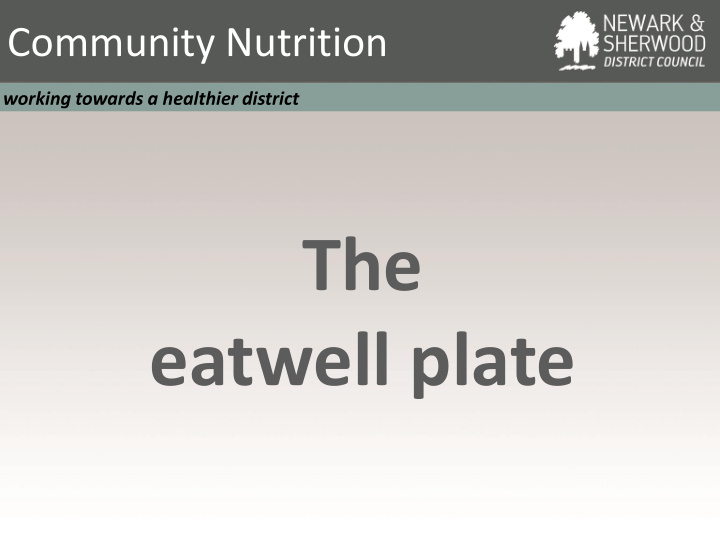



Community Nutrition working towards a healthier district The eatwell plate
Eatwell plate
Eatwell plate • Categorises most of the food we eat into five groups • Groups based on nutrients provided • Shows the different proportions • Suitable for most people whether they are a normal weight or over weight • Not suitable for children under two • Those with special medical/dietary conditions should seek advice before following the eatwell plate
Fruits and Vegetables • Aim for 5 portions everyday • One portion is equal to a handful or approx 80g • Except for dried fruit – middle of your palm • Fresh, frozen, dried, canned and juice all count • Provide vitamins and minerals • Needed to keep our bodies healthy but also used with other nutrients for various functions to keep us alive • Good source of fibre
Bread, Rice, Potatoes and Pasta • Source of carbohydrates providing good energy for the body • This energy keeps blood sugar more stable • Base three daily meals around carbohydrates • Choose wholemeal options where possible • Good source of fibre for the body • Soluble and insoluble • Not fattening – only 4kcals per gram • It’s how much you eat and how you cook them
Milk and Dairy foods • Group contains only milks, cheeses and yoghurts • Need three portions everyday • Provides calcium for bone and tooth health • Also regulates muscle contraction and helps the blood to clot • Can be high in saturated fat which has an impact on cholesterol • Choose lower fat options wherever possible • Lower in fat does not mean lower in calcium
Meat, Fish, Eggs and Beans • Provides protein needed for growth and repair • 2 – 3 portions a day. Try to have two portions of fish each week, one being oily • Also provides Iron, selenium and B vitamins • Main source of Vitamin B 12 • Meat naturally high in saturated fat • Reduce fat by selecting leaner cuts, removing fat and skin and limiting oil during cooking • Like carbohydrates, just 4 kcals per gram
Fatty and Sugary foods • Contains all those foods we like to eat • High in fat, sugar, salt and calories • Should be eaten as a treat every now and again • Very good source of energy but it is absorbed and used very quickly – peaks and troughs • Empty calories – only food group we don’t need • Need to eat more to reach satiety • Fat provides 9kcals per gram – more than double the amount of carbohydrates
Eight tips for eating well 1. Base your meals on 5. Try to eat less salt – no starchy carbohydrates more than 6g a day for adults 2. Eat lots of fruits and vegetables 6. Get active and try to be healthy weight 3. Eat more fish – including a portion of 7. Drink plenty of water – oily fish each week 1 – 1.5 litres a day 4. Cut down on saturated 8. Don't skip breakfast fat and sugar
Recommend
More recommend